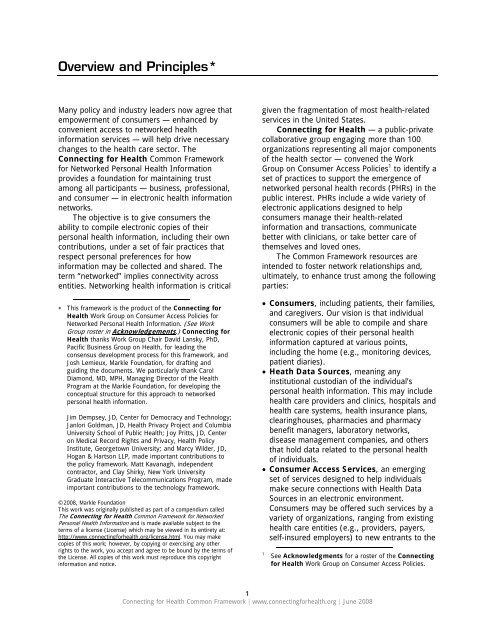CF-Consumers-Full
CF-Consumers-Full
CF-Consumers-Full
You also want an ePaper? Increase the reach of your titles
YUMPU automatically turns print PDFs into web optimized ePapers that Google loves.
Overview and Principles*<br />
Many policy and industry leaders now agree that<br />
empowerment of consumers — enhanced by<br />
convenient access to networked health<br />
information services — will help drive necessary<br />
changes to the health care sector. The<br />
Connecting for Health Common Framework<br />
for Networked Personal Health Information<br />
provides a foundation for maintaining trust<br />
among all participants — business, professional,<br />
and consumer — in electronic health information<br />
networks. ∗<br />
The objective is to give consumers the<br />
ability to compile electronic copies of their<br />
personal health information, including their own<br />
contributions, under a set of fair practices that<br />
respect personal preferences for how<br />
information may be collected and shared. The<br />
term “networked” implies connectivity across<br />
entities. Networking health information is critical<br />
∗ This framework is the product of the Connecting for<br />
Health Work Group on Consumer Access Policies for<br />
Networked Personal Health Information. (See Work<br />
Group roster in Acknowledgements.) Connecting for<br />
Health thanks Work Group Chair David Lansky, PhD,<br />
Pacific Business Group on Health, for leading the<br />
consensus development process for this framework, and<br />
Josh Lemieux, Markle Foundation, for drafting and<br />
guiding the documents. We particularly thank Carol<br />
Diamond, MD, MPH, Managing Director of the Health<br />
Program at the Markle Foundation, for developing the<br />
conceptual structure for this approach to networked<br />
personal health information.<br />
Jim Dempsey, JD, Center for Democracy and Technology;<br />
Janlori Goldman, JD, Health Privacy Project and Columbia<br />
University School of Public Health; Joy Pritts, JD, Center<br />
on Medical Record Rights and Privacy, Health Policy<br />
Institute, Georgetown University; and Marcy Wilder, JD,<br />
Hogan & Hartson LLP, made important contributions to<br />
the policy framework. Matt Kavanagh, independent<br />
contractor, and Clay Shirky, New York University<br />
Graduate Interactive Telecommunications Program, made<br />
important contributions to the technology framework.<br />
©2008, Markle Foundation<br />
This work was originally published as part of a compendium called<br />
The Connecting for Health Common Framework for Networked<br />
Personal Health Information and is made available subject to the<br />
terms of a license (License) which may be viewed in its entirety at:<br />
http://www.connectingforhealth.org/license.html. You may make<br />
copies of this work; however, by copying or exercising any other<br />
rights to the work, you accept and agree to be bound by the terms of<br />
the License. All copies of this work must reproduce this copyright<br />
information and notice.<br />
given the fragmentation of most health-related<br />
services in the United States.<br />
Connecting for Health — a public-private<br />
collaborative group engaging more than 100<br />
organizations representing all major components<br />
of the health sector — convened the Work<br />
Group on Consumer Access Policies 1 to identify a<br />
set of practices to support the emergence of<br />
networked personal health records (PHRs) in the<br />
public interest. PHRs include a wide variety of<br />
electronic applications designed to help<br />
consumers manage their health-related<br />
information and transactions, communicate<br />
better with clinicians, or take better care of<br />
themselves and loved ones.<br />
The Common Framework resources are<br />
intended to foster network relationships and,<br />
ultimately, to enhance trust among the following<br />
parties:<br />
• <strong>Consumers</strong>, including patients, their families,<br />
and caregivers. Our vision is that individual<br />
consumers will be able to compile and share<br />
electronic copies of their personal health<br />
information captured at various points,<br />
including the home (e.g., monitoring devices,<br />
patient diaries).<br />
• Heath Data Sources, meaning any<br />
institutional custodian of the individual’s<br />
personal health information. This may include<br />
health care providers and clinics, hospitals and<br />
health care systems, health insurance plans,<br />
clearinghouses, pharmacies and pharmacy<br />
benefit managers, laboratory networks,<br />
disease management companies, and others<br />
that hold data related to the personal health<br />
of individuals.<br />
• Consumer Access Services, an emerging<br />
set of services designed to help individuals<br />
make secure connections with Health Data<br />
Sources in an electronic environment.<br />
<strong>Consumers</strong> may be offered such services by a<br />
variety of organizations, ranging from existing<br />
health care entities (e.g., providers, payers,<br />
self-insured employers) to new entrants to the<br />
1<br />
See Acknowledgments for a roster of the Connecting<br />
for Health Work Group on Consumer Access Policies.<br />
1<br />
Connecting for Health Common Framework | www.connectingforhealth.org | June 2008



